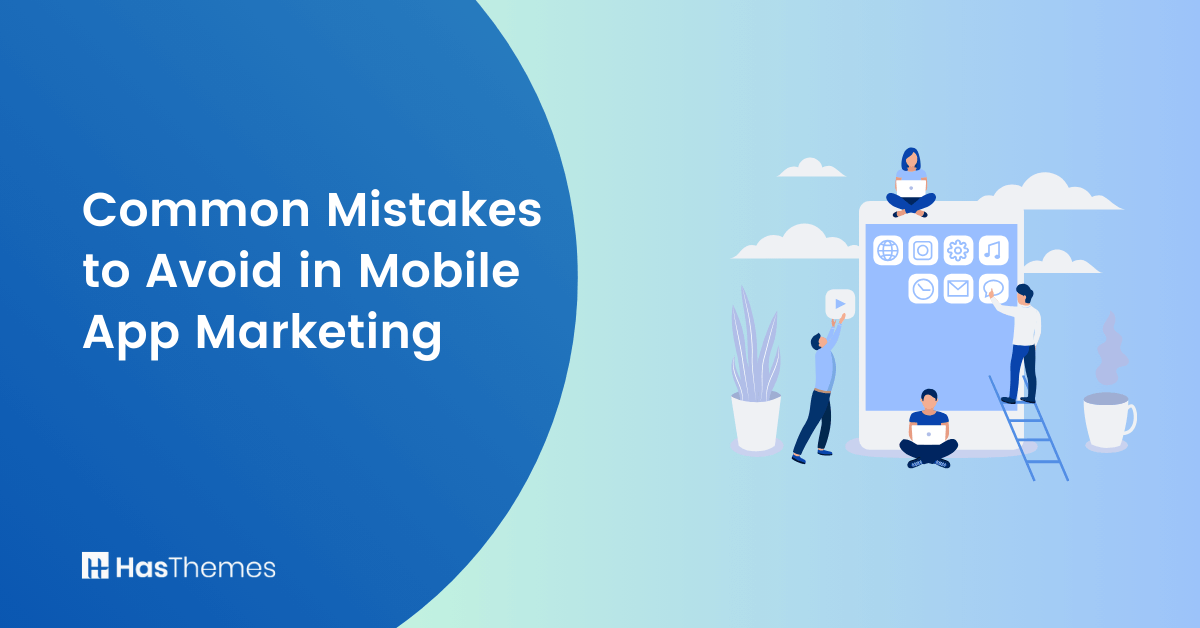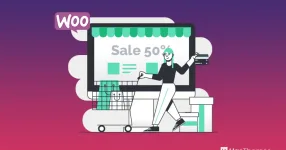
10 Common Mistakes to Avoid in Mobile App Marketing
Marketing an application is like navigating a maze. One wrong turn can lead you astray. Doing it successfully is a specialized science that requires a keen understanding of the market, audience, and technology. But even seasoned marketers can stumble. In this article, we will try to identify common mistakes and learn how to avoid them.
What is Mobile App Marketing?

Promoting an application by creating a relationship with the user is called mobile application marketing. It targets potential clients across various channels and, as opposed to mobile marketing, zeroes in on promoting a specific app. It’s like comparing a billboard that everyone sees to a personalized invitation to an exclusive event.
In 2024, Google Play has 2.87 million apps, and the Apple App Store isn’t far behind. With such a crowded marketplace, standing out is a challenge. This is why it is so important to learn the art of making your application visible, attractive, and engaging. It’s not just about getting downloads — it’s about keeping clients coming back.
10 Common Mistakes in Mobile App Marketing

Even seasoned marketers can stumble, making mistakes that may hinder their success. In this section, we’ll explore ten common missteps and how to steer clear of them.
#1 Ignoring User Feedback
Imagine building a product without knowing what your customers want. Ignoring feedback is like shooting in the dark. Companies like Amazon continually evolve based on customer reviews. They have built entire features and products around what customers are asking for.
Working with feedback isn’t limited to addressing complaints. It also involves understanding what one loves, hates, and needs. It’s a goldmine of insights that can drive your application’s development, feature enhancement, and overall experience. Engage with your clients, ask for their opinions, and most importantly, act on what you learn.
#2 Poorly Defined Target Audience
Selling to everyone is selling to no one. Without a clear target audience, your message gets lost in the noise. Think of Coca-Cola — they know their audience and tailor their strategies accordingly. They don’t just sell soda. They sell happiness and refreshment to a specific demographic.
Understanding your target audience means knowing their age, interests, behaviors, and pain points. It means creating a persona that you can speak to directly through your promotional efforts. This clarity helps in crafting messages that resonate, creating advertisements that engage, and building a product that truly serves its users.
#3 Lack of Post-Launch Strategy
Launching an app is just the beginning. Without a post-launch strategy, user engagement can plummet. Netflix constantly updates its content to keep the audience engaged. They don’t just release shows and movies. They create seasons, series, and a continuous flow of new content that keeps users coming back. Your product needs a similar ongoing strategy.
What will keep one engaged after the initial download? How will you continue to provide value? Whether it’s through regular updates, new features, community engagement, or content creation, a robust post-launch strategy is a must.
#4 Ineffective ASO
ASO or App Store Optimization is like SEO for applications. Without it, your product becomes a needle in a haystack. Angry Birds and similar games soared to success partly due to effective ASO. They understood the importance of keywords, descriptions, titles, and user reviews in making an app discoverable. But ASO isn’t confined to visibility — it’s conversion, too.
How does your application’s icon look? What do the screenshots convey? Are your ratings and reviews positive? All these factors play a role in getting your product seen and downloaded. Invest in expert ASO solutions as you would in SEO for a website, and watch your visibility and downloads grow.
#5 Overlooking Analytics
Analytics is the compass of your promotional journey. Without it, you’re lost. Take Google — they rely heavily on analytics. They don’t just track clicks and downloads. Instead, they analyze user behavior, engagement patterns, conversion funnels, and much more. Embrace data, and let it guide your decisions.
Understand where your clients come from, what they do within your application, what makes them stay, and what turns them away. This isn’t just about numbers but insights that can shape your marketing strategy. Enhance your product’s functionality and drive growth.
#6 Spammy Notifications
Nobody likes spam. Overloading users with notifications is a surefire way to lose them. Balance is key, as demonstrated by Slack. They don’t just notify — they inform, engage, and even entertain.
Notifications should be timely, relevant, and valuable. They should serve the client, not annoy them. Whether it’s a reminder, an update, or a special offer, make sure it’s something the user will appreciate. And always give them the control to choose what they want to be notified about.
#7 Ignoring Cross-Platform Compatibility
Not all mobile users are the same. Ignoring cross-platform compatibility is like opening a store that only serves a fraction of the community. WhatsApp succeeded by being accessible to everyone, regardless of the device or operating system. This isn’t just about reaching more people. You must provide a consistent experience across platforms, too.
Don’t skimp on the services of trusted development agencies such as Velvetech LLC — with their help, you can get a solution that looks, feels, and functions the same whether it’s on an iPhone, an Android device, or a tablet. This consistency builds trust and broadens your reach.
#8 Weak Onboarding Experience
First impressions matter. A confusing onboarding process can turn users away. Duolingo excels by making the first experience engaging and simple. They guide you through the process, teaching you how to use the key functions as you go along.
Onboarding is teaching, yes, but it’s also welcoming. It’s your application’s first handshake, first smile, first impression. Make it count. Make it enjoyable. And most importantly, make it valuable. Show users why they downloaded your solution in the first place, and give them reasons to stay.
#9 Lack of Personalization
People crave personal connections. Generic selling feels cold and distant. Spotify’s personalized playlists are a great example of connecting with users on an individual level. They don’t simply play songs — they play “your” songs.
Personalization means understanding individual preferences, behaviors, and needs. It means creating an experience that feels tailor-made. Whether it’s through personalized content, recommendations, or interfaces, making your product feel like it’s “mine” can significantly enhance user loyalty.
#10 Underestimating the Importance of Visuals
A picture is worth a thousand words. Poor visuals can undermine your application’s credibility. Look at Instagram: its success is built on visual appeal. But visuals aren’t only about looking good. They likewise help to communicate effectively.
Your app’s design, images, icons, and videos should tell a story, convey a message, and guide the user. They should be more than mere decoration. They should enhance usability, strengthen branding, and create an emotional connection. Invest in professional design, use high-quality images, and ensure that every visual element serves a purpose.
Best Tips for Promoting Your Mobile Application

Understanding how to best sell your mobile solution can be akin to charting a course through unexplored territory. But fear not, the path to success is illuminated by tried-and-true strategies. Just as a seasoned explorer relies on a compass and map, these tips will guide you through.
Video Promotion
Videos can be a powerful tool to showcase your product’s features and benefits. Think of how Apple uses sleek video demonstrations for its new solutions. Create engaging videos that resonate with your audience.
User-Generated Content
Encourage users to share their experiences and create content around your application. It’s like having ambassadors who spread the word organically. GoPro’s user-generated content campaigns are a great example of this strategy in action.
Gamification Techniques
Make the experience fun and engaging by incorporating game-like elements. Think of Duolingo which uses gamification to keep clients motivated and engaged.
Other Apps
Find synergies with other applications and create partnerships. Collaboration can expand your reach and provide additional value to your clients. Learn from Uber and Spotify that partnered to enhance the ride experience.
User Retention
Acquiring first clients is just the start. Retaining them is the real challenge. Implement features that keep them coming back such as loyalty programs or regular content updates. Take a closer look at Amazon Prime’s continuous addition of new content — it is an actionable strategy that keeps subscribers engaged.
Social Media
Social media is the town square of the digital age. Engage with your audience there, share updates, and encourage feedback. Brands like Nike excel in social media engagement so it’s a good idea to learn from them.
Incentives for Referrals
Referrals are word-of-mouth in the digital world. Encourage them with rewards, and watch your popularity grow. Dropbox’s referral program is a classic success story, leading to a 60% increase in sign-ups.
Influencers
Influencers are modern-day celebrities. Partner with them to boost your product’s visibility. Brands like Daniel Wellington are great models in this regard.
Final Thoughts
Promoting a mobile application is a journey filled with twists and turns. Yet, if you understand the common mistakes and learn from real-world examples, you’ll cope. Remember, the success of the entire endeavor doesn’t just depend on a great idea. It’s about connecting with your audience, understanding their needs, and continually evolving. The path is exciting, challenging, and rewarding. Are you ready to take the next step?



